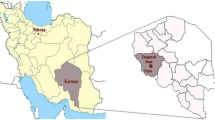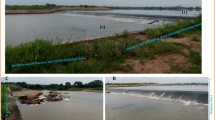Abstract
Ethiopia is currently developing irrigation schemes like micro dams to improve its food security. Chalchal Dam project is one of such dams to be constructed in the Bale Zone of Southeastern Ethiopia. However, this dam is subjected to engineering geological problems due to the presence of carbonate and shale rocks in this area. To address this problem, engineering geological mapping, discontinuity surveying, core drilling, geophysical surveying, in situ permeability, and laboratory testing were carried out. From these integrated investigations, the dam site is underlain by colluvial and alluvial soil deposits, sandstone, limestone with decomposed shale, shale, marly limestone, and massive limestone rocks with different degrees of weathering and fracturing. The Lugeon test conducted along the dam axis revealed the presence of potential seepage zones at the left abutment and river center in which the former is underlain by highly permeable rocks with Lugeon values as high as 39.58 and the latter with permeable rocks with a Lugeon value of 9. The geo-mechanical properties of rocks such as friction angle, cohesion, and modulus of deformation at the dam site, as determined using Hoek–Brown failure criteria, were in ranges of 21.52 to 32.06°, 0.123 to 3.006 MPa, and 0.747 to 9.308 GPa, respectively. The bearing capacity of the dam foundation was determined using empirical methods and the result pointed out that the allowable bearing capacity of the dam foundation ranges from 0.116 to 5.321 MPa. After the removal of colluvial and alluvial deposits along the dam axis, ground improvements were recommended along the dam axis mainly in terms of curtain grout and slurry trench or concrete cutoff.










Similar content being viewed by others
References
Abay A, Meisina C (2015) Engineering-geological properties of carbonates and shale: their implications for dam construction in Mekelle, Northern Ethiopia. Momona Ethiopian Journal of Science 7(1):64. https://doi.org/10.4314/mejs.v7i1.117238
Abdulkadir M (2009) Assessment of micro-dam irrigation projects and runoff predictions for ungauged catchments in northern Ethiopia. PhD dissertation, Muenster University, Germany. http://d-nb.info/1000437884/34
Bell F (2007) Engineering Geology, (2nd ed.). Butterworth-Heinemann (Elsevier) Burlington, MA. pp .581
Berhane G (2010) Geological, geophysical and engineering geological investigation of a leaky micro-dam in the Northern Ethiopia. Agricultural Engineering International: the CIGR Journal 12(1):31–46
Berhane G, Kristine M, Nawal AF, Kristine W (2013) Water leakage investigation of microdam reservoirs in Mesozoic sedimentary sequences in Northern Ethiopia. J Afr Earth Sc 79:98–110
Bieniawski ZT (1989) Engineering rock mass classifications: a complete manual for engineers and geologists in mining, civil, and petroleum engineering. Wiley, xii, New York, p 251
Canoğlu B, Mustafa C, Bedri K (2017) Determination of the dam axis permeability for the design and the optimization of grout curtain: an example from Orhanlar Dam (Kütahya Pazarlar). Special Issue (Recent Topics in Environmental Science)
Choi SY, and Park HD (2004) Variation of the rock quality designation (RQD) with scanline orientation and length: a case study in Korea. Int. J. of Rock Mech. & Mining Sciences, 41, 207- 221
Deere DU, Deere DW (1988) The rock quality designation (RQD) index in practice. In: Kirakaldie L (ed) Rock Classification systems for engineering purposes. ASTM special publication 984. American Society for Testing Materials, Philadelphia, pp 91–101
De Hamer W, Love D, Owen R, Booij MJ, Hoekstra AY (2008) Potential water supply of a small reservoir and alluvial aquifer system in southern Zimbabwe. Phys Chem Earth 33:633–639
Desta LT (2005) Reservoir siltation in Ethiopia: causes, source areas and management options. PhD dissertation, University of Bonn, Germany
Ewert FK (1997) Permeability, groutability and grouting of rocks related to dam sites, Part 2. Dam Eng 8(2):123–176
FAO (2005) Global information and early warning system on food and agriculture. World food program. Special report. Italy, Rome
Fell R, MacGregor P, Stapledon D, Bell G, Foster M (2015) Geotechnical engineering of dams, 2nd edn. Taylor & Francis Group, London
Foster M, Fell R, Spannagle M (2000) The statistics of embankment dam failures and accidents. Can Geotech J 37(5):1000–1024
Foyo A, Sanchez MA, Tomillo C (2005) A proposal for a secondary permeability index obtained from water pressure tests in dam foundations. Eng Geol 77:69–82
Garrido A, Martínez-Santos P, Llamas MR (2006) Groundwater irrigation and its implications for water policy in semiarid countries: the Spanish experience. Hydrogeol J 14:340–349
Ghafoori M, Lashkaripour GR, Tarigh AS (2011) Investigation of the geological and geotechnical characteristics of Daroongar dam, Northeast Iran. Geotech Geol Eng 29:961–975. https://doi.org/10.1007/s10706-011-9429-6
Ghazifard A, Heidari E, Hashemi M, Hangara A (2006) Evaluation of engineering geological characteristics for the Kuhrang III dam site, Iran. In: 10th IAEG international congress, 6–10 Sept 2006, Nottingham, United Kingdom
Ghobadi MH, Khanlari GR, Djalali H (2005) Seepage problems in the right abutment of the Shahid Abbaspour Dam, Southern Iran. Engineering Geology, Vol. 82, Issue 2. Elsevier, Pp. 119–126
Gurocak Z, Alemdag S (2011) Assessment of permeability and injection depth at the Atasudam site (Turkey) based on experimental and numerical analyses. Bulletin of Engineering Geology and the Environment: DOI https://doi.org/10.1007/s10064-011-0400-9
GWP (2010) Global water security Global Water Partnership Secretariat. (Drottninggatan 33, SE-111 51 Stockholm, Sweden)
Haregeweyn N, Poesen J, Nyssen J, De Wit J, Haile M, Govers G, Deckers S (2006) Reservoirs in Tigray (northern Ethiopia): characteristics and sediment deposition problems. Land Degrad Dev 17:211–230
Hamm SY, Kim M, Cheong JY, Kim JY, Son M, Kim TW (2007) Relationship between hydraulic conductivity and fracture properties estimated from packer tests and borehole data in a granite. Eng Geol 92:73–87
Houlsby AC (1976) Routine interpretation of the Lugeon water test. Q J Eng Geol 9:303–313
Houlsby AC (1990) Construction and design of cement grouting: a guide to grouting in rock foundation. Wiley, New Jersey
ISRM (1981) Suggested methods for the quantitative description of discontinuities in rock masses. In: Barton N (ed) Rock characterization, testing and monitoring. Pergamon, Oxford
Kamal LB (2007) Investigation of water leakage mechanisms in the karst Dam site, Samanalawewa, Sri Lanka. PhD Thesis, Saga University, Saga, Japan
Lashkaripour GR, Ghafoori M (2002) The engineering geology of the Tabarak Abad Dam. J Eng Geol 66:233–239
Lee CH, Farmer I (1993) Fluid flow in discontinuous rocks. Chapman & Hall, New York
Maerz NH, Zhou W (1999) Multivariate analysis of borehole discontinuity data. Rock Mechanics for Industry, Proceedings of the 37th US Rock Mechanics Symposium, Vail Colorado, June 6–9, 1: 431 –438
Malkawi AH, Al-Sheriadeh M, (2000) Evaluation and rehabilitation of dam seepage problems, a case study: Kafrein Dam. Engineering Geology, Vol. 56, Issues 3–4. Elsevier, Pp. 335 345
Morteza M (2012) Water leakage paths in the Doosti Dam, Turkmenistan and Iran. Environ. Earth Sci 65:103–117
MoWR (2001) Ethiopian water sector strategy. Addis Ababa, Ethiopia
Mozafari M, Raeisi E, Zare M (2011) Water leakage paths in the Doosti Dam, Turkmenistan and Iran. Environmental Earth Science. DOI https://doi.org/10.1007/s12665-011-1069-x
Nappi M, Esposito L, Piscopo V, Rega G (2005) Hydraulic characterization of some arenaceous rocks of Molise (Southern Italy) through outcropping measurements and Lugeon tests. Eng Geol 81:54–64
Nusier OK, Alawneh AS, Malkawi AH (2002) Remedial measures to control seepage problems in the Kafrein Dam, Jordan. Bulletin of Engineering Geology and the Environments, Vol. 16. Springer, Pp. 145–152
OWWDSE (2018) Geotechnical investigation report of Chalchal Dam site. Unpuplished Technical report, Addis Ababa
Özsan A, Akin M (2002) Engineerimg geological assessment of the proposed Urus Dam, Turkey. Eng Geol 66:271–281
Quinones-Rozo C (2010) Lugeon test interpretation, Revisited. In: Proceedings of the 30th Annual US society of dams (USSD) Conference Sacramento, California, April 12–16, 2010, pp 4.5–414
Reza G, Ali A (2012) The analysis of engineering properties of the rock mass of Ghordanloo dam site. NE Iran 2(9):17–27
Rocscience (2004) Dips 6.0. http://www.rocscience.com/software/dips. Accessed 14 May 2020
Rocscience (2004) Rocdata 3.0. http://www.rocscience.com/software/rocdata. Accessed 3 Aug 2020
Romanov D, Gabrysek F, Dreybrodt, W (2003) Dam sites in soluble rocks: a model of increasing leakage by dissolution widening of fractures beneath a dam. Engineering Geology, Vol. 70, Issues 1–2. Elsevier, Pp. 17–35
Scanlon BR, Keese KE, Flint AL, Flint LE, Gaye CB, Edmunds WM, Simmers I (2006) Global synthesis of groundwater recharge in semiarid and arid regions. Hydrogeol J 3370:3335–3370
Sharghi Y, Siahkoohi H, Alinia F, Moarefvan P (2010) Estimation of Lugeon number at the abutments of Bakhtyari Dam site using seismic tomography. Aust J Basic Appl Sci 4(2):274–285
Sissakian V, Adamo N, Al-Ansari N (2019) The role of geological investigations for dam siting: Mosul Dam a case study. Geotechnical And Geological Engineering
Stare DP, Dreese TL, Bruce DA (2013) Contemporary drilling and grouting methods. In: Bruce DA (ed) Specialty Construction Techniques for Dam and Levee Remediation. CRC Press, London, pp 15–106
Tiruneh M (2005) Reservoir Operational Planning of Irrigation Dams for MicroHydropower Development. A Case Study Conducted on Haiba Micro-irrigation Earth Dam in Tigray Regional State. M.Sc. thesis, Addis Ababa University, Ethiopia
Tosun H (2011) Earthquake safety evaluation of Keban dam, Turkey. CDA Annual Conference, Fredericton, Canada
Uromeihy A, Farrokhi R (2011) Evaluating groutability at the KamalSaleh Dam based on Lugeon tests. Bull Eng Geol Environ. https://doi.org/10.1007/s10064-011-0382-7
USBR (1987) Design of small dams. United States Department of the Interior, Bureau of Reclamation, Denver
Vandecasteele I, Nyssen J, Clymans W, Moeyersons J, Martens K, Camp M, Gebreyohannes T, Desmedt F, Deckers J, Walraevens K (2011) Hydrogeology and groundwater flow in a basalt-capped Mesozoic sedimentary series of the Ethiopian highlands. Hydrogeol J 19:641–650
von Braun J, Olofinbiyi T (2007) Famine and food insecurity in Ethiopia: case study #7–4 of the program: “Food Policy for Developing Countries: The role of government in the global food system”. Cornell University
Warner J (2004) Practical handbook of grouting; soil, rock, and structures. Wiley, New Jersey
Weaver K (1991) Dam foundation grouting. American Society of Civil Engineers, New York
WORLD BANK (2008) Ethiopia: a country study on the economic impacts of climate change, Environment and natural resource management. Sustainable Development Department Africa Region: Development Prospects Group, World Bank Document
WSDP (2002) Water sector development program 2002– 2016, Volume II: Main report. Addis Ababa, Ethiopia
Wyllie DC, Mah CW (2004) Rock Slope Engineering 4thEd. The Institution of Mining and Metallurgi London
Acknowledgements
The authors would like to thank Oromia Water Works Design and Supervision Enterprise (OWWDSE) and Oromia Irrigation Development Authority (OIDA) for providing the necessary data and for allowing us to work with them with a good sense of collaboration. We are also grateful to Addis Ababa Science and Technology University (AASTU), particularly, the Department of Geology and the Department of Civil Engineering for providing the necessary field equipment for field work data collection. Any contributions from journal papers, scientific reports and books have been cited and acknowledged.
Author information
Authors and Affiliations
Contributions
The first author has done the data collection, analysis, and draft write up of the manuscript. The second author commented and enriched in each phase of the manuscript writing. Both authors read and approved the final manuscript.
Corresponding author
Ethics declarations
Competing interests
The authors declare no competing interests.
Additional information
Responsible editor: Zeynal Abiddin Erguler
Rights and permissions
About this article
Cite this article
Garo, T., Meten, M. Engineering geological characterization for evaluation of seepage and geomechanical properties of Chalchal Dam Site, Bale Zone, Southeastern Ethiopia. Arab J Geosci 14, 2549 (2021). https://doi.org/10.1007/s12517-021-08881-8
Received:
Accepted:
Published:
DOI: https://doi.org/10.1007/s12517-021-08881-8




